RHESUS MACAQUE
Macaca mulatta
Physical Description
Macaques are second only to humans in their ability to use their fingertips and opposable thumbs to manipulate small objects. The Rhesus Macaque has brown fur, with light underparts, and red skin. The Macaque’s face, ears, and rump are hairless. The Rhesus Macaque has cheek pouches to carry food in while foraging. The Macaque’s body length ranges from 45 to 65 centimetres (18 to 26 inches), and the Macaque’s tail length ranges from 19 to 32 centimetres (7.5 to 13 inches).
The average height of male Rhesus macaques measures from 48 to 63.5 centimetres (19 to 25 inches), while the average height of females measures from 47 to 53 centimetres (18.5 to 20.9 inches). Male macaques weigh from 6.5 to 12 kilograms (14 to 26 pounds) and females weigh an average of 3.3 kilograms (7.3 pounds).
Habitat
The Rhesus Macaque is found in a wide range of habitats, ranging from barren areas to dense forest, from very cold to very hot climates, and elevations from sea level up to 2,500 metres (8,200 feet).
Several sub-populations of the Macaque have adapted to urban environments. The Macaque has disappeared from much of its original range, but still occurs in Tibet, China, Nepal, Bhutan, Bangladesh, Burma (Myanmar), Thailand, Vietnam, Laos, India, Pakistan, and Afghanistan.
Eating Habits
The Rhesus Macaque is omnivorous, and its diet varies across its habitat range and according to the season. The Macaque’s diet may include insects, leaves, fruit, flowers, berries, grain, grass, ground herbs, and algae. The Rhesus Macaque sometimes raids crop fields, gardens, and garbage cans for food.
Behaviour and Reproduction
The Rhesus Macaque is equally comfortable in the trees and on the ground, and is also a good swimmer. The Macaque lives in groups consisting of both females and males. Male macaques are dominant within the groups. Males switch groups every few years, but females stay associated in a strict matrilineal hierarchy. Macaque group sizes often reach into the hundreds, and rarely number below 20 monkeys. The Rhesus Macaque is not territorial.
The Rhesus Macaque generally reaches sexual maturity between 3.5 to four years of age. During the mating season, the buttocks and back of the legs of female and male macaques deepen in colour to a bright red. The timing of the mating season varies across the Rhesus Macaque’s habitat range. Macaques that live in cold areas mate in the fall and give birth in spring. The Rhesus Macaque’s gestation period is from 135 to 194 days. Each macaque mother typically gives birth to just one offspring. Offspring weigh about 450 grams (16 ounces) at birth. Mothers give birth again the following year or two years later. Rhesus macaques in captivity may live for up to 30 years.
Present Status
The Rhesus Macaque is categorized as Lower Risk: Near Threatened in the 2003 IUCN Red List of Threatened Species and is listed under Appendix II of CITES. The Rhesus Macaque is under second class protection in China.
Threats to Survival
The main threat to the Rhesus Macaque’s survival is habitat loss. The Macaque may also be poached, for the pet trade, or persecuted, because of its crop-raiding tendencies. The Rhesus Macaque is widely used as a test subject in scientific experiments, especially within the fields of biology, medicine, and psychology.
References
BBC, Science & Nature – Wildfacts – Rhesus monkey, http://www.bbc.co.uk/nature/wildfacts/factfiles/211.shtml, Aug 2004.
Eudey, A. & Members of the Primate Specialist Group, 2000: Macaca mulatta. In: IUCN, 2003: 2003 IUCN Red List of Threatened
Species, http://www.redlist.org, Aug 2004.
Flannery, Sean, Oct 2003: Rhesus Macaque (Macaca Mulata), http://members.tripod.com/uakari/macaca_mulatta.html, Aug 2004.
Seinfeld, J., 2000, Macaca mulatta, Animal Diversity Web, http://animaldiversity.ummz.umich.edu/site/accounts/information/
Macaca_mulatta.html, Aug 2004.
Singapore Zoological Gardens, 2000: Rhesus Macaque (Macaca Mulatta), http://www.szgdocent.org/pp/p-mcrhes.htm, Aug 2004.
By: Environment and Development Desk, DIIR, CTA.



comment 0